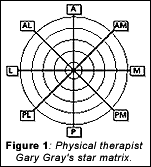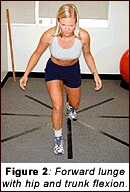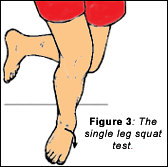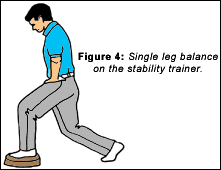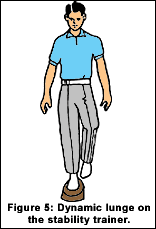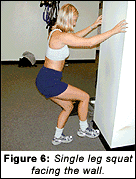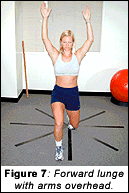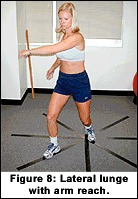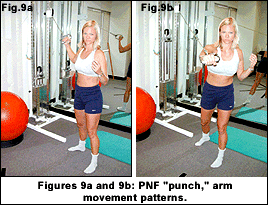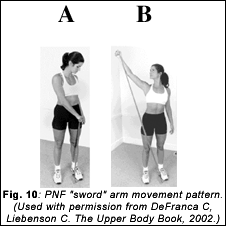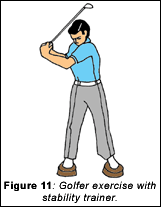A valuable training principle to understand is that training causes "specific adaptation to imposed demands (SAID)."12 These adaptations are specific to the length, movement and speed of the exercise.11 An example is knee extensors (quadriceps) trained on the seated-knee-extension progressive resistance machine, that do not become stronger after training with a bicycle.11
An excellent illustration of functional exercises are the 3-D lunges, single-leg balance challenges and squats taught by Gary Gray,PT.2,7,10 These utilize a star matrix floor pattern so that tri-planar movement (sagittal, frontal and transverse) can be trained (see Fig. 1). When unstable surfaces, such as a stability trainer or balance board, are used in conjunction with balance, lunge or squat exercises, the effects can be amplified.4,6 Balogun demonstrated that by exercising on a balance board, lower extremity strength improved more than if four separate resistance machine exercises are performed.1 Similarly, Vera-Garcia showed that trunk curl-ups on a gymnastic ball increased oblique abdominal activity fourfold vs. floor training.14
The primary goal of rehabilitation is to facilitate an individual's ability to manage daily tasks without causing pain or injury. Occasionally, manipulation is all that is needed to accomplish this. However, exercise is also frequently required. The problem in practice is determining the realistic targets of care. Specifically, can discreet functional deficits be identified that are related to a patient's daily activities? Can these be improved with manipulation or exercise?
Assessment
How does a practitioner know if a patient's ability to manage daily tasks safely has been restored? If manipulation restores joint play and reduces painful range of motion, can it be assumed that daily activities are automatically stabilized? As numerous studies show that ROM impairments correlate poorly with activity intolerances or disability,5,9,15 more direct measures should be evaluated.
The clinician should identify which specific activities of daily living, job demands, or sports and recreational activities are the primary sources of biomechanical overload in the locomotor system. History and examination are necessary to arrive at a "functional diagnosis." Activity intolerance questionnaires (i.e., Oswestry), the history of aggravating factors, and tests of "real-world" functional tasks (squatting, lunging, balancing, loaded reaches, etc.) are used.13 This "functional diagnosis" can be combined with the patient's structural diagnosis (i.e., pain generator) to guide the clinician in selecting what treatments are most effective in patient care. For instance, a patient with a structural diagnosis of a herniated disc; a functional diagnosis of pain with prolonged sitting; and an inability to perform a forward lunge without flexing the trunk and hip will require training that facilitates lunging and kneeling, while maintaining the lumbar lordosis (see Fig. 2).
A simple screen for functional performance ability of the lower quarter is to have your patient perform a single leg squat. Compare one side to the other, looking for asymmetry of depth; Trendelenberg's sign; hip flexion; tibial torsion; or hyperpronation (see Fig. 3).
Training
The simplest way to determine if manipulation has adequately rehabilitated function is to perform posttreatment checks of relevant functional deficits. If function is not restored, functional training is indicated. There are two basic principles to follow when prescribing a new exercise. The first is the McKenzie principle: Movement should centralize, rather than peripheralize symptoms.8 Second (a cognitive-behavioral principle): Hurt does not necessarily equal harm.3 The patient should be informed that light activity won't injure him, and that deconditioned tissues are typically uncomfortable to move because they are stiff.
A simple way for the patient to begin functional training is in the single-leg-stance balance position. Start with the eyes open and attempt to perform a 10-second hold. Six repetitions twice a day are the goal. When this can be accomplished, progress to performing it with your eyes closed. The next progression is to balance on one foot on the stability trainer (see Figure 4). Again, perform it first with eyes open; once mastered, perform it with your eyes closed.
Always progress to the next level of exercise when six repetitions (with a 10-second hold per repetition) are achieved.
A simple progression is to perform a dynamic lunge exercise, first on the floor, and then on the stability trainer (see Fig. 5). These exercises are performed repetitively in each different direction on the star matrix diagram (front, side, and back), which optimizes function (i.e., decreases hyperpronation). When 12 repetitions can be performed slowly without jerky movements, progress onto lunging with the stability trainer.
Another challenging functional exercise is the single leg squat. It is usually very difficult for a patient to perform this while balancing, so it is modified by placing the fingertips on a wall (see Fig. 6). This should also be performed first with eyes open, until 12 slow repetitions can be controlled, then one can progress to "eyes closed." Then, repetitions with both eyes open and closed can be performed on the stability trainer.
Lunges and single-leg squats can become tri-planar exercises (movement in all three planes of motion) by adding arm reaches. The correct arm motion will even improve squat or lunge performance, and should be searched for when a patient has difficulty with functional movement. For instance, if a person's forward lunge occurs with a great deal of hip or trunk flexion, asking him to raise the arms overhead will automatically drive extension (see Fig. 7). If hyperpronation is present, an arm reach across the body, along with an oblique or lateral lunge, will automatically facilitate supination (see Figure 8).
Other arm movements, like punches, or proprioceptive neuromuscular facilitation (PNF) patterns such as the "sword" or "seatbelt," can also be used (see Figures 9 and 10). Bands or cables are the only equipment required.
The final common pathway for functional exercises are movements that mimic the sports or activities an individual performs. The stabilty trainer is ideal for challenging balance, coordination, strength and endurance in these functional positions and movements (see Fig. 11).
Summary
Functional stability training is the final goal of rehabilitation. Yet, manipulation and nonweightbearing exercises do not necessarily need to precede more functional upright training. As the saying goes, "Begin with the end in mind." By incorporating functional whole body movements and balance training, the deep core muscles can be trained. This will promote joint stability and prevent injury.
References
- Bologun JA, Adesinasi CO, Marzouk DK. The effects of a wobble board exercise training program on static balance performance and strength of lower extremity muscles. Physiother Can 1992;44:23-30.
- Gray G. Rehabilitation Institute of Chicago. Functional approach to musculoskeletal system II seminar, October 2001. For further information, visit www.wynnmarketing.com.
- Indahl A, Haldorsen EH, Holm S, Reikeras O, Hursin H. Five-year follow-up study of a controlled clinical trial using light mobilization and an informative approach to low back pain. Spine 1998;23:2625-2630.
- Janda V, Va' vrova' M. Sensory motor stimulation. In; Liebenson C (ed). Spinal Rehabilitation: A Manual of Active Care Procedures. Baltimore, Williams and Wilkins, 1996.
- Klein AB, Snyder-Mackler L, Roy SH, et al. Comparison of spinal mobility and isometric trunk extensor forces with electromyographic spectral analysis in identifying low back pain. Phys Ther 1991;71(6):445-454.
- Liebenson CS. Advice for the clinician and patient: Sensory-motor training. Journal of Bodywork and Movement Therapies 2001;5(1):21-28.
- Liebenson CS. Advice for the clinician and patient: Functional exercises. Journal of Bodywork and Movement Therapies 2002;6(2)108-116.
- McKenzie RA. The Lumbar Spine: Mechanical Diagnosis and Therapy. Spinal Publications, Waikanae, NZ 1981.
- Nattrass CL, Nitschke JE, Disler PB, et al. Lumbar spine range of motion as a measure of physical and functional impairment: an investigation of validity. Clin Rehabil 1999;13(3):211-8.
- Risberg MA, Mork M, Krogstad JH, Holm I. Design and implementation of a neuromuscular training program following anterior cruciate ligament reconstruction. JOSPT 2001;31:620-631.
- Rutherford OM. Muscular coordination and strength training, implications for injury rehabilitation. Sports Med 1988;5:196.
- Sale D, MacDougall D. Specificity in strength training: A review for the coach and athlete. Can J Sport Sci 1981;6:87.
- Simmonds MJ, Lee CE. Physical performance tests: an expanded model of assessment and outcome. In: Liebenson C (ed). Rehabilitation of the Spine: A Practitioner's Manual, 2nd edition. Lippincott/Williams and Wilkins, Baltimore, 2002 (sched pub).
- Vera Garcia FJ, Grenier SG, McGill SM. Abdominal response during curl-ups on both stable and labile surfaces. Phys Ther 2000;80(6):564-569.
- Waddell G, Somerville D, Henderson I, et al. Objective clinical evaluation of physical impairment in chronic low back pain. Spine 1992;17:617-28.
Los Angeles, California
Click here for previous articles by Craig Liebenson, DC.






